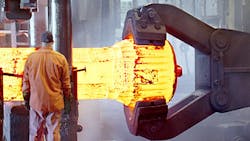Labor disputes used to be big deals, offering insights to the economic situation in particular industries, and about the status of individual workers there. In 1986, a five-month strike by the United Steelworkers against U.S. Steel was seen as the death throes of both integrated steelmaking and industrial unions. If you didn’t understand anything about manufacturing or labor, or industrial economics, you would know by the news of the strike that both sides were fighting not simply for a financial gain but to hold on to something they could not lose and still survive.
A brief labor dispute in late summer by almost 300 workers at a forging company left me with quite a different impression. I am glad to report the strike was settled and the workers are returned to their jobs, but the meaning of a labor strike seems to have changed too.
First, it must be recognized that labor has changed in the past 30 years. Human labor is still necessary in various industrial functions, including forging, obviously, but it’s not the determining factor in economic planning that it was then. Labor is more important in other sectors — retail, service, and agriculture, especially, but even in those areas the role of human labor and decision making is being supplanted by automation.
Employers, including operations managers, know that process automation makes human involvement in manufacturing less essential than it once was. Even if that is not true in every example, the financial interests that make every business viable believe in the value of process control and automation and will readily approve the investments needed to make operations more reliable and more productive.
As it happened, around the same time that the forge shop workers mentioned above were striking over their wage and benefits packages, I was attending a technology conference that offered several program tracks on industrial automation. I was there as a guest, an observer. The real audience were manufacturing operations managers, business chiefs, and investors. They were considering the future, and without exception the visions projected to them involved automation: Level 1 automation to control functions like time, speed, force, temperature, etc.; Level 2 automation to convey details of work-in-progress to Level 3, which coordinates work with orders and schedules.
All these functions oversee activities within an individual production line. Some plants have multiple production lines, but more important than this is the scale of activity at the next higher level, where the conversation begins to reference ‘digitalization’. Not in the future, but now, there is integrated communication from production machinery out of the plant, through a dedicated network, to a Cloud-centered database that is coordinating such communications among dozens or hundreds of machines. There may be humans nearby to run reports or evaluate some results, but there is no threat of a labor stoppage.
It’s not hard to imagine how this has changed “work” or “labor”. According to recent Wall Street Journal report, individual workers are working more hours than they did 40 years ago, but with less stable employment and more frequent changes in employer and work assignment. In 1973, 6% of Americans said they worked excessive hours; in 2016, 26% said they worked more than 48 hours a week. Employers’ insurance coverage for individuals is down on a per-capita basis since 1973, too. Employers spend less on compensation, training, and capital investment. Either as a cause or an effect, workers increasingly behave as free agents: they may appreciate having more control and flexibility over their income by moving from job to job, but reliability and predictability now belongs to employers who have automated their operations.
All of which takes me back to the forging workers’ strike last summer. They may have sought a better deal on wages and benefits, but their message was even clearer: “We’re still here.”
About the Author
Robert Brooks
Editor/Content Director - Endeavor Business Media
Robert Brooks has been a business-to-business reporter, writer, editor, and columnist for more than 20 years, specializing in the primary metal and basic manufacturing industries. His work has covered a wide range of topics including process technology, resource development, material selection, product design, workforce development, and industrial market strategies, among others.
Currently, he specializes in subjects related to metal component and product design, development, and manufacturing—including castings, forgings, machined parts, and fabrications.
Brooks is a graduate of Kenyon College (B.A. English, Political Science) and Emory University (M.A. English.)

